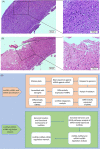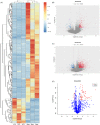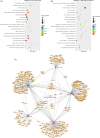Genome-wide analysis of acute traumatic spinal cord injury-related RNA expression profiles and uncovering of a regulatory axis in spinal fibrotic scars
- PMID: 33150698
- PMCID: PMC7791181
- DOI: 10.1111/cpr.12951
Genome-wide analysis of acute traumatic spinal cord injury-related RNA expression profiles and uncovering of a regulatory axis in spinal fibrotic scars
Abstract
Objectives: Long non-coding RNAs (lncRNAs) are critical for posttranscriptional and transcriptional regulation in eukaryotic cells. However, data on lncRNA expression in the lesion epicentres of spinal tissues after acute traumatic spinal cord injury (ATSCI) are scarce. We aimed to identify lncRNA expression profiles in such centres and predict latent regulatory networks.
Materials and methods: High-throughput RNA-sequencing was used to profile the expression and regulatory patterns of lncRNAs, microRNAs and messenger RNAs (mRNAs) in an ATSCI C57BL/6 mouse model. Chromosome distributions, open reading frames (ORFs), transcript abundances, exon numbers and lengths were compared between lncRNAs and mRNAs. Gene ontology, KEGG pathways and binding networks were analysed. The findings were validated by qRT-PCRs and luciferase assays.
Results: Intronic lncRNAs were the most common differentially expressed lncRNA. Most lncRNAs had <6 exons, and lncRNAs had shorter lengths and lesser ORFs than mRNAs. MiR-21a-5p had the most significant differential expression and bound to the differentially expressed lncRNA ENSMUST00000195880. The microRNAs and lncRNAs with significant differential expression were screened, and a lncRNA/miRNA/mRNA interaction network was predicted, constructed and verified.
Conclusions: The regulatory actions of this network may play a role in the pathophysiology of ATSCI. Our findings may lead to better understanding of potential ncRNA biomarkers and confer better therapeutic strategies for ATSCIs.
Keywords: acute traumatic spinal cord injury; interaction network; long non-coding RNAs; mRNA; miRNA.
© 2020 The Authors. Cell Proliferation Published by John Wiley & Sons Ltd.
Conflict of interest statement
The authors declare no conflict of interests. The sponsors had no role in the design, execution, interpretation or writing of the study, or in the decision to publish the results.
Figures








Similar articles
-
Identification of noncoding RNA expression profiles and regulatory interaction networks following traumatic spinal cord injury by sequence analysis.Aging (Albany NY). 2019 Apr 18;11(8):2352-2368. doi: 10.18632/aging.101919. Aging (Albany NY). 2019. PMID: 30998503 Free PMC article.
-
Identification and coregulation pattern analysis of long noncoding RNAs following subacute spinal cord injury.J Orthop Res. 2022 Mar;40(3):661-673. doi: 10.1002/jor.25101. Epub 2021 Jun 6. J Orthop Res. 2022. PMID: 33991009 Free PMC article.
-
Biomarkers mining for spinal cord injury based on integrated multi-transcriptome expression profile data.J Orthop Surg Res. 2021 Apr 16;16(1):267. doi: 10.1186/s13018-021-02392-8. J Orthop Surg Res. 2021. PMID: 33863336 Free PMC article.
-
[Non-coding RNAs as therapeutic targets in spinal cord injury].Zh Vopr Neirokhir Im N N Burdenko. 2020;84(4):104-110. doi: 10.17116/neiro202084031104. Zh Vopr Neirokhir Im N N Burdenko. 2020. PMID: 32759933 Review. Russian.
-
Microarray and Bioinformatics Analysis of Differential Gene and lncRNA Expression during Erythropoietin Treatment of Acute Spinal Cord Injury in Rats.Comput Math Methods Med. 2022 Sep 2;2022:4121910. doi: 10.1155/2022/4121910. eCollection 2022. Comput Math Methods Med. 2022. Retraction in: Comput Math Methods Med. 2023 Dec 6;2023:9843413. doi: 10.1155/2023/9843413. PMID: 36092786 Free PMC article. Retracted. Review.
Cited by
-
Single-cell RNA sequencing reveals the role of immune-related autophagy in spinal cord injury in rats.Front Immunol. 2022 Sep 21;13:987344. doi: 10.3389/fimmu.2022.987344. eCollection 2022. Front Immunol. 2022. PMID: 36211348 Free PMC article.
-
miR-6315 silencing protects against spinal cord injury through the Smo and anti-ferroptosis pathway.Biosci Rep. 2023 Apr 26;43(4):BSR20230030. doi: 10.1042/BSR20230030. Biosci Rep. 2023. PMID: 36946310 Free PMC article.
-
The mechanism by which hyperbaric oxygen treatment alleviates spinal cord injury: genome-wide transcriptome analysis.Neural Regen Res. 2022 Dec;17(12):2737-2742. doi: 10.4103/1673-5374.339498. Neural Regen Res. 2022. PMID: 35662222 Free PMC article.
-
MiRNAs as Promising Translational Strategies for Neuronal Repair and Regeneration in Spinal Cord Injury.Cells. 2022 Jul 12;11(14):2177. doi: 10.3390/cells11142177. Cells. 2022. PMID: 35883621 Free PMC article. Review.
-
New Insight of Circular RNAs' Roles in Central Nervous System Post-Traumatic Injury.Front Neurosci. 2021 Mar 23;15:644239. doi: 10.3389/fnins.2021.644239. eCollection 2021. Front Neurosci. 2021. PMID: 33841083 Free PMC article.
References
-
- Harvey LA, Dunlop SA, Churilov L, Galea MP. Early intensive hand rehabilitation is not more effective than usual care plus one‐to‐one hand therapy in people with sub‐acute spinal cord injury ('Hands On'): a randomised trial. J Physiother. 2017;63(4):197‐204. - PubMed
-
- Hara M, Kobayakawa K, Ohkawa Y, et al. Interaction of reactive astrocytes with type I collagen induces astrocytic scar formation through the integrin‐N‐cadherin pathway after spinal cord injury. Nat Med. 2017;23(7):818‐828. - PubMed
MeSH terms
Substances
Grants and funding
- NO.2019JDRC0100/The Innovation and Entrepreneurship Project of Sichuan Technology Gallery
- NO.20MZGC0265/The Innovation and Entrepreneurship Project of Sichuan Technology Gallery
- Z20192013/the National Clinical Research Center for Geriatrics, West China Hospital, Sichuan University
- Y2018B22/the National Clinical Research Center for Geriatrics, West China Hospital, Sichuan University
- NO.2018SZ0159/the Science and Technology Support Project of Sichuan Province
LinkOut - more resources
Full Text Sources
Medical

